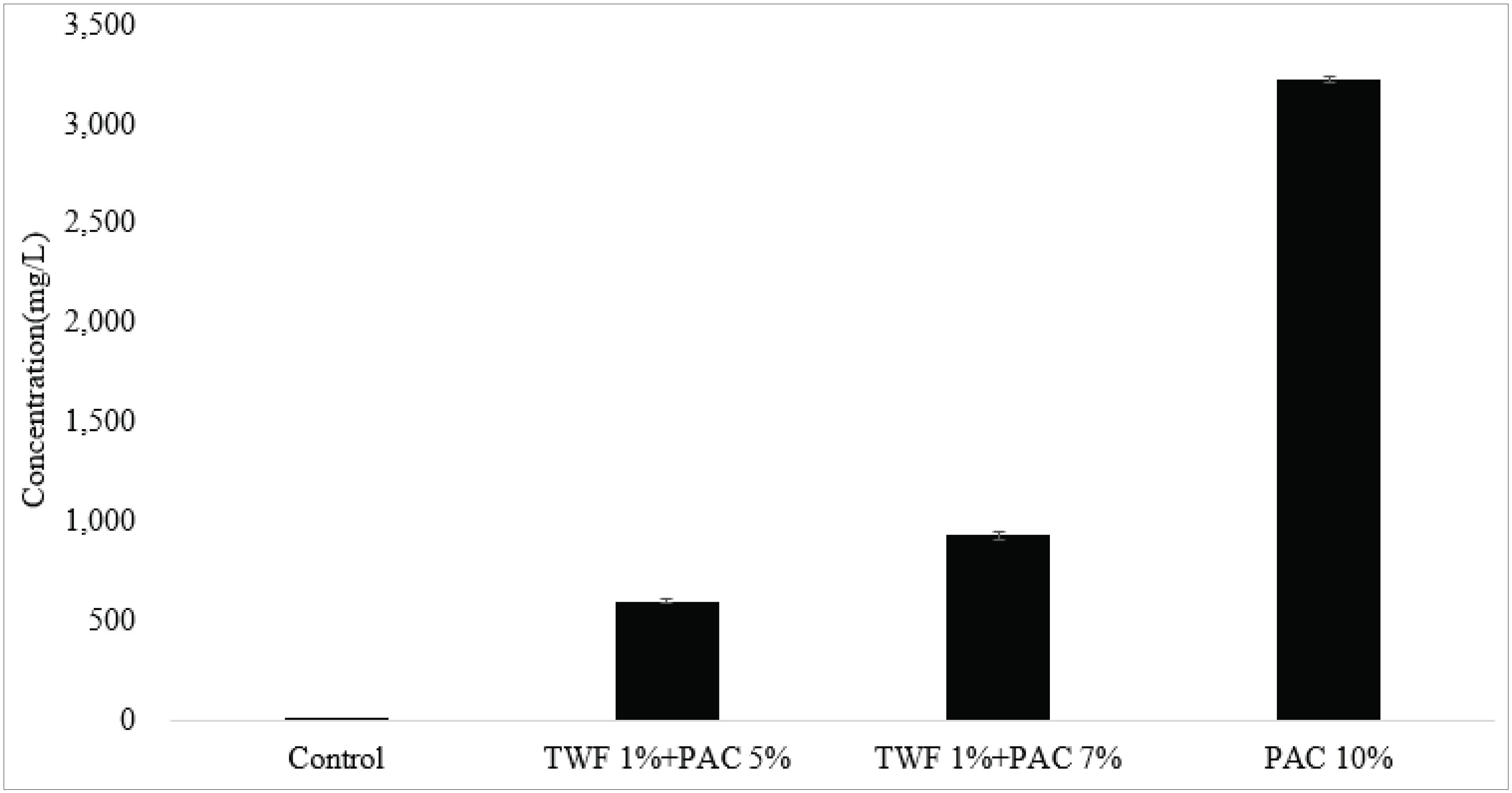1. INTRODUCTION
With the rapid industrialization and the occurrence of abnormal climate based on this, the importance of water quality in water-intake sources, streams and the management costs are increasing every year (Hwang et al., 2018). In Korea, for the management of total phosphorus and total nitrogen which are the major pollutants in water quality pollution, coagulants are injected in sewage treatment plants and the water-dissolved organic compounds are processed by blending, coagulation, and sedimentation processes. The use of PAC accounts to 58% of all domestic coagulants. Although PAC has a very high content of impurities (heavy metals) on the quality standard, the standard is not properly reinforced. Thus, an excessive injection of coagulant increases the residual aluminum con centration, which leads to the secondary pollution (Park, 2009). While it is different for all the existing wastewater treatment plants based on incoming water quality, in general, 1ppm of 17% PAC coagulant is being injected sequentially, and up to 50ppm is being injected to reduce the total phosphorus of incoming water. For treated water with an excessive amount of coagulant in the same aluminum series with PAC, the water-dissolved aluminum ion could be flowed in drinking water. Moreover, if the dissolved aluminum ion is flowed in human body, it could cause neurological diseases such as Alzheimer’s, etc. (Han et al., 2016). In addition, rapid changes in environmental laws occurred after mid-2000 that include prohibition of ocean disposal, policy on pollution load management system, high level processing of sewage treatment plants, installation of total phosphorus processing facilities, and energy self-reliance projects, etc. As such, the domestic environmental medicine market is emphasizing the significance of coagulant application technology and technical management on changes in products and pollution load (MOE, 2017). Biomass is known to be an environmentally friendly resource that can be regenerated in the aspect of resource circulation (Gong et al., 2016). As such, a study is being conducted on the applicability of coagulant that combines natural materials of vegetal and mineral substances, etc. (Nam et al., 2016). If biomass (wood, etc.) is being used as a fuel that goes through thermolysis process and torrefaction process as natural material, the caloric value increases due to the increase in fixed carbon, and the water content is reduced due to thermolysis of hydrophilic functional groups (Jung et al., 2018; Priadi et al., 2019; Chang et al., 2019; Kim et al., 2019; Kim et al., 2018).
In addition, torrefaction is a heat treatment method which applies heat of relatively lower temperature of 200-300°C in anaerobic or nitrogen environment, to reduce contents of moisture, acid compounds with low calories, and hemicellulose that exist in wood biomasses (Lee et al., 2016; Nam et al., 2018).
As such, this study conducted two separate studies based on a previous study: Using a forest by-product of woods damaged by blight and harmful insects to analyze charge and absorption performances of Torrefied Wood Flour manufactured in a high-temperature treatment condition (Yang et al., 2016), and a study on algae removal efficiency of paste coagulant manufactured by combining Torrefied Wood Flour showing a strong negative charge based on heat treatment and cationic polyacrylamide (Yang et at., 2017). The previous study combined the cationic polymer coagulant with Torrefied Wood Flour to manufacture the combined coagulant showing cationic property through surface-modification process. In addition, the study focused on water pollutants according to the principle of removing organic compounds which cause water quality pollution, such as anionic organic compound T-P, etc. (Yang et al., 2019).
Therefore, this study aimed to reduce the use of Torrefied Wood Flour used by the previous study and PAC used in the existing sewage treatment plants. In order to achieve this, Torrefied Wood Flour mixed PAC coagulant was used to analyze water pollutants removal efficiency based on the mixed coagulant concentration to evaluate the applicability of mixed coagulant. The evaluation items are turbidity, total phosphorus, and total nitrogen. This study also aimed to verify the optimal mixing ratio of mixed coagulant, as well as possibility of removing underwater pollutants through results derived from the evaluation.
2. MATERIALS and METHODS
For Torrefied Wood Flour used as the test material, an oak tree chip for pulp with water content of 12% similar to the one used in the previous study was used. The material of torrefied chip was received from S corporation in Gumi which performed a rapid heattreatment for 25 minutes at a temperature of 250 °C using superheated steam. The torrefied chip treated with superheated steam was grinded using a small high-speed pulverizer (Wonder Blender) in order to secure uniformity of particles. The used Torrefied Wood Flour was a portion (Zeta potential of more than –40 mV) with the size of 75 um ~ 106 um which is the maximum configuration of distribution based on particle size (Yang et al., 2019).
As an inorganic polymer coagulant, PAC is configured with chemical formula of (OHm)Cl6-m]n, and it is a coagulant in polymer series made by hydrochloric acid and aluminum. A colorless and a lemon-yellow transparent liquid coagulant were used. PAC is an inorganic polymer chemical compound with alkaline multinuclearized-ion structure having cationic charge, and it shows a strong coagulation (Choi et al., 2016). A commonly used coagulant PAC was used to manufacture the Torrefied Wood Flour mixed coagulant.
In order to derive the optimal content of Torrefied Wood Flour during the manufacturing process of Torrefied Wood Flour mixed coagulant, this study manufactured mixed coagulant which combined Torrefied Wood Flour grinded through the superheated steam treatment and PAC which is a coagulant in market by diluting them in certain concentration. The mixed coagulant was manufactured as shown in Table 1 below, by setting a mixing ratio with Torrefied Wood Flour contents of 0.5%, 1%, 5%, and 10% with the coagulant PAC (10%) in market. Moreover, the test material for this experiment was manufactured by adding Torrefied Wood Flour to 500 ml PAC (10%), and mixing at 800 rpm for approximately 5 hours (Yang et al., 2016).
| Division | 0.5% TWF | 1% TWF | 5% TWF | 10% TWF |
|---|---|---|---|---|
| PAC (10%) | 500 ml | |||
| TWF | 1 g | 5 g | 25 g | 50 g |
This study determined that 1% content of Torrefied Wood Flour is the optimal addition by considering the organic compound removal efficiency through the previous experiment for deriving the optimal content of Torrefied Wood Flour. In addition, in order to reduce content of PAC to secure economic feasibility and environmental stability, the experiment in this study manufactured the test material by diluting the Torrefied Wood Flour in PAC concentrations of 2%, 5%, 7%, and 10% based on 1% addition of Torrefied Wood Flour, and mixing it for approximately 5 hours at 800 rpm, as shown in Table 2.
| Division | 2% PAC | 5% PAC | 7% PAC | 10% PAC |
|---|---|---|---|---|
| TWF | 5 g | |||
| PAC | 100 ml | 250 ml | 350 ml | 500 ml |
As shown in Table 1 and Table 2, in order to evaluate organic compound removal efficiency based on conditions of each mixed coagulant manufactured, the outflowing water of primary settling pond at Daejeon sewage treatment plant having a high content of organic compound in water was used. The collected primary settling pond’s outflowing water was divided at 1L in 1L beaker using a volumetric flask, and Jar test was performed according to mixed coagulant conditions. Supernatant was collected by going through operating conditions of Jar test as follows: rapid max at 140 rpm 2 min, show-paced mix at 40 rpm 20 min, and sedimentation time of 30 min. After the supernatant was collected, it was filtered through a syringe filter with 45 um opening, and used as the analysis sample. Total phosphorus and total nitrogen were selected as the analysis items, which belong to turbidity and ion of general items in 「Water Pollution Standard Method (No. 2017-4)」.
In order to evaluate turbidity of the primary settling pond outflowing water and treated water, a turbidimeter (Turbidimeter TB 210 IR, Lovibond, Germany) was used for the measurement with 5 times repetition and the analysis was based on turbidity analysis criteria of 「Water Pollution Standard Method (No. 2017-4)」. The turbidimeter has the minimum detection limit of over 0.02 NTU (Nephelometric Turbidity Units), and it is equipped with a light source, and a photoelectric detector. In addition, the light source of tungsten filament operates at a temperature range of 2,200 K-3,000 K, the total passing distance of incident light and scattered light inside the measuring tube does not exceed 10cm, and the angle that absorbed light by the detector does not exceed (90±30)°C with respect to incident light.
In order to evaluate the total phosphorus of the primary settling pond outflowing water and treated water, the total phosphorus of 「Water Pollution Standard Method (No. 2017-4)」 was measured by using a water quality analyzer (HS-3300, HUMAS) which complies with Ascorbic Acid Reductionism, etc. and it was measured 5 times in repetition.
In order to evaluate the total nitrogen of the primary settling pond outflowing water and treated water, the total nitrogen of 「Water Pollution Standard Method (No. 2017-4)」 was measured by using a water quality analyzer (HS-3300, HUMAS) which complies with optical density measurement based on chromatography method, and it was measured 5 times in repetition.
In order to evaluate the aluminum concentration of the primary settling pond outflowing water and treated water, the aluminum among heavy metals of 「Water Pollution Standard Method (No. 2017-4)」 was analyzed. The analysis of the sample was performed by FITI Testing & Research Institute, and it was measured 3 times in repetition according to inductively coupled plasma/atomic emission spectrometry.
3. RESULTS and DISCUSSION
In order to evaluate in-water organic compound removal efficiency and turbidity removal efficiency using polluted water collected from the primary settling pond at Daejeon sewage treatment plant, turbidity, total phosphorus, and total nitrogen items between polluted and treated water were measured. The result of analyzing the quality of outflowing water of primary settling pond at Daejeon sewage treatment plant are shown in Table 3. In the case of turbidity, it was revealed to be not suitable with turbidity 15 NTU which belongs to SS (suspended solid), level 5 criteria among discharge water quality criteria (MOE, 2013). In the cases of T-P and T-N, it wasrevealed as exceeding 0.15 mg/L, level 5 criteria among discharge water quality criteria.
| Division | Characteristics |
|---|---|
| Turbidity (unit : NTU) | 60 ± 0.7 |
| T-P (unit : mg/L) | 4.11 ± 0.02 |
| T-N (unit : mg/L) | 33.785 ± 0.085 |
T-P and T-N are the representative organic compounds that cause water pollution. The higher concentration of these organic compounds results in facilitation of eutrophication due to the compounds or growth of microorganism in water. In addition, the water quality pollution is worsened due to the leak of toxic substances based on microorganism. The efficiency of removal of organic compound according to the content of torrefied wood and PAC(10%) is shown in Fig. 1. The contents of Torrefied Wood Flour were selected as 0.5%, 1%, 2%, and 5% by referring to the previously conducted study to manufacture the mixed coagulant. In addition, T-P, T-N, and turbidity removal efficiency based on the injection amount of the manufactured mixed coagulant was indicated.
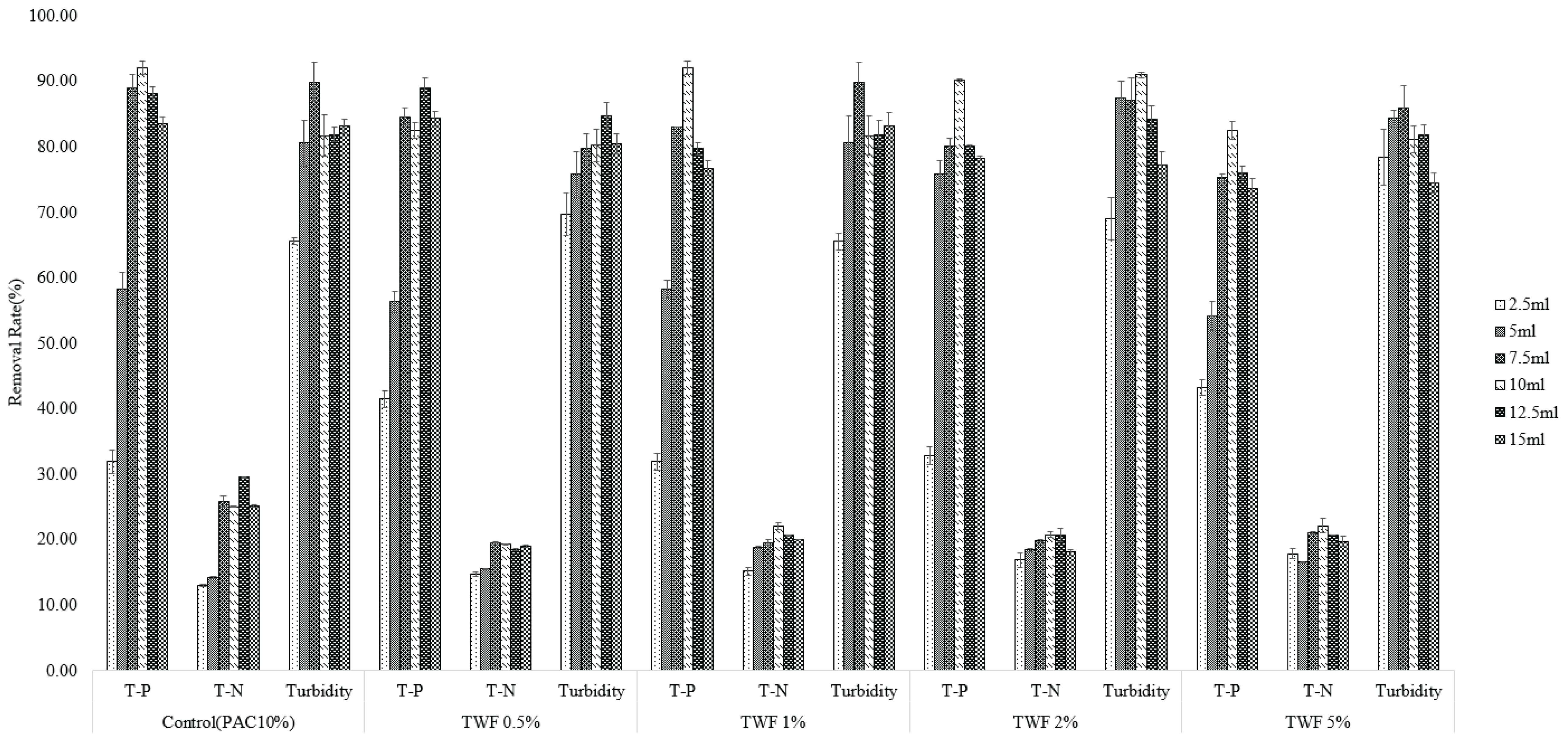
As shown in Fig. 1, the removal efficiency of organic compounds in mixed coagulant containing 1% torrefied wood flour was relatively high. In the case of T-P, the maximum removal efficiency of approximately 92% was shown in PAC 10% coagulant 10 ml. In the case of T-N, approximately 22% was shown in TWF 1%+PAC 7% coagulant 10 ml. The organic compound constituting the total nitrogen reveals a positive charge and it showed a relatively less coagulation effect than the organic compound of total phosphorus showing a negative charge due to positive charge of PAC. In the case of turbidity, it can be seen that it shows a high removal efficiency of approximately 91% at maximum, if the injection amount of coagulant is 10 ml.
Furthermore, Jar test was performed to evaluate the coagulant performance. It was confirmed that if Torrefied Wood Flour is included, the flocs are generated quickly. Thus, it was determined that 1% content of Torrefied Wood Flour is the optimal addition at the time of manufacturing the mixed coagulant for removing the organic compounds.
Considering the previously performed organic compound removal efficiency result based on Torrefied Wood Flour content, 1% content of Torrefied Wood Flour was determined to be the optimal addition. Thus, this experiment aimed to analyze the organic compounds removal efficiency based on PAC concentration reduction, in the cases of PAC concentrations of 2%, 5%, 7%, and 10% with respect to 1% addition of Torrefied Wood Flour. The mixed coagulant removal efficiency based on PAC concentration according to 1% content of Torrefied Wood Flour is shown in Fig. 2. In addition, it also indicates T-P, T-N, and turbidity removal efficiency based on the injection amount of the manufactured mixed coagulant.
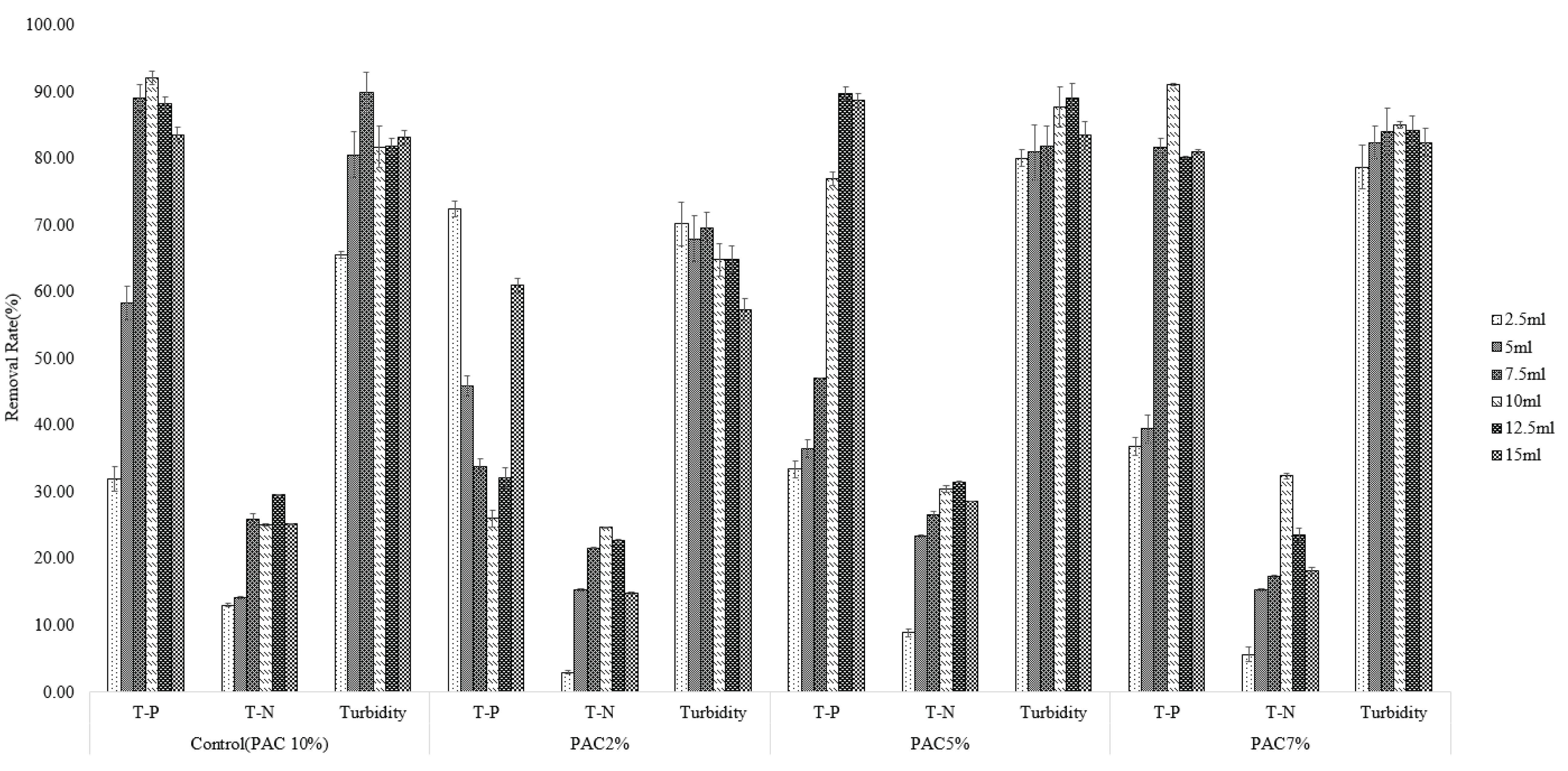
As shown in Fig. 2, it can be seen that the organic compound removal efficiency is relatively higher when 1% of Torrefied Wood Flour is included and PAC concentration is 7%. In the case of T-P, it showed a high removal efficiency of maximum of 91% if the injection amount of coagulant is 10 ml. It can confirm that it shows a similar removal efficiency with the coagulation performance result of the mixed coagulant with 1% of Torrefied Wood Flour and 10% PAC concentration. In the case of T-N, it shows approximately 32% of removal efficiency with 10 ml of injection amount of coagulant. This result is presumed to be achieved by a similar cause with the previous experiment result for selecting the optimal content of Torrefied Wood Flour. In the case of turbidity, the maximum removal efficiency of approximately 90% was indicated when PAC concentration was 7% based on 1% content of Torrefied Wood Flour, and 10 ml injection amount of coagulant. In addition, when 1% of Torrefied Wood Flour is included and PAC concentration was 5%, it shows a relatively less removal efficiency than when PAC concentration was 7%. However, with 12.5 ml injection amount of coagulant, T-P showed 90% of removal efficiency, whereas T-N showed approximately 32%, and turbidity showed 89%.
As a result of performing Jar test per concentration of mixed coagulant with reduced PAC concentration based on 1% content of Torrefied Wood Flour, it was confirmed that reducing PAC concentration by 30%- 50% could secure a similar removal efficiency with when the existing PAC (10%) is injected.
Based on the previous experiments, it was determined that the optimal removal effect of organic material was achieved at a concentration of 7% of PAC for 1% of Torrefied Wood Flour. An experiment was conducted to compare and analyze the removal efficiency of organic compounds and PAC (10%) which is a market coagulant, with the final optimal efficiency. The efficiency of T-P, T-N and turbidity removal of the mixed coagulant which has 7% concentration and PAC (10%) coagulant based on 1% Torrefied Wood Flour content is shown in Fig. 3, Fig. 4, Fig. 5.
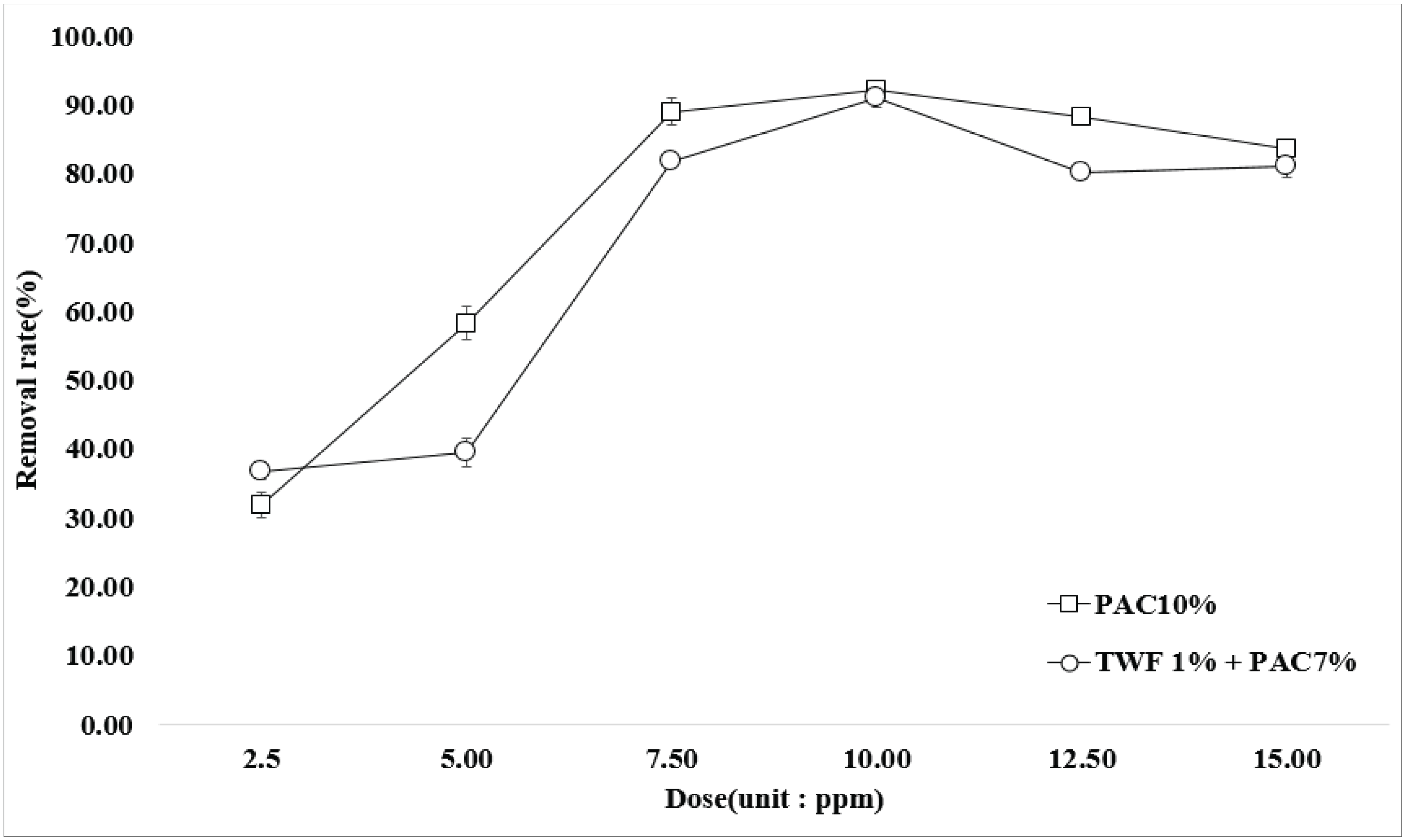
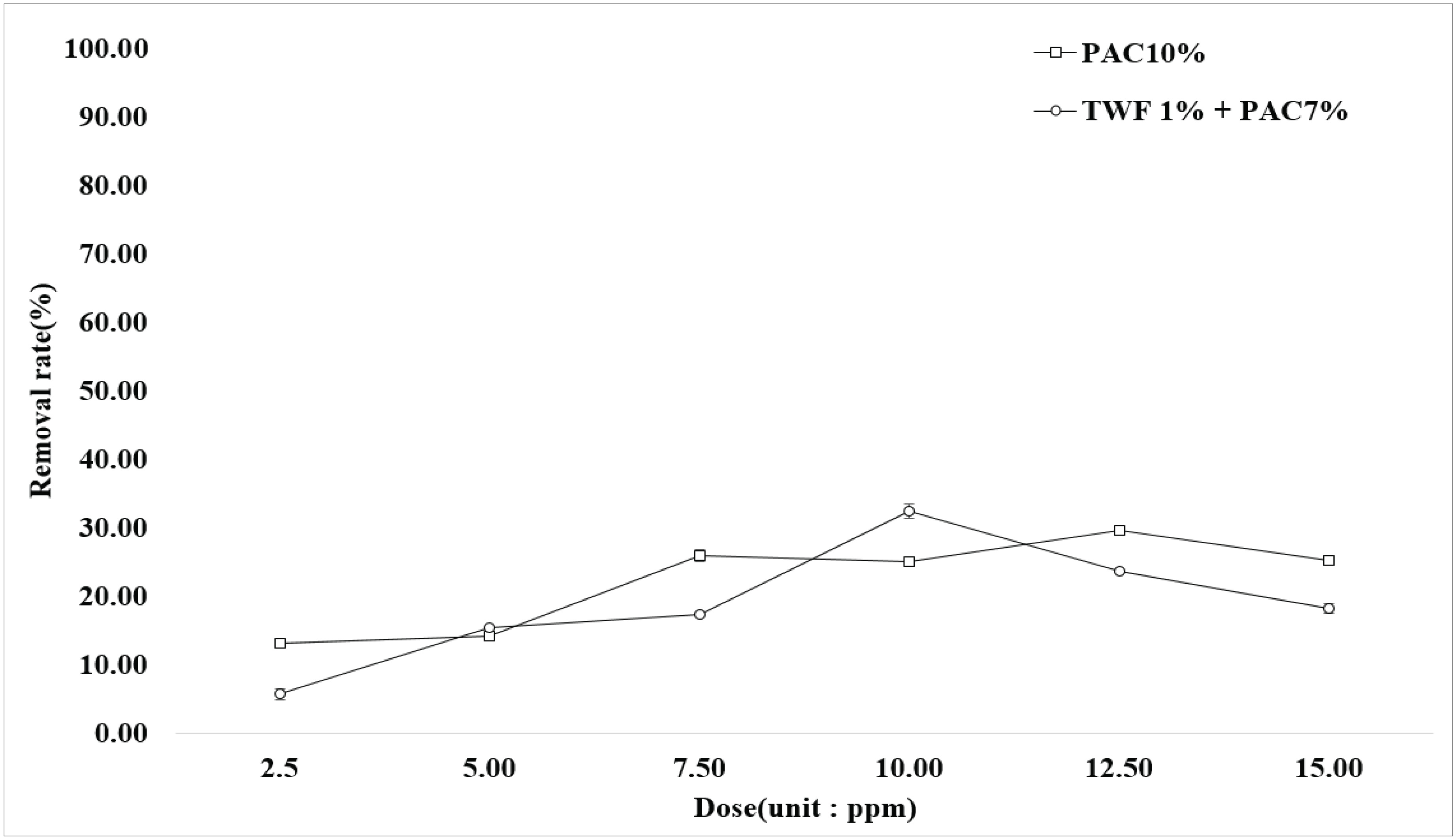
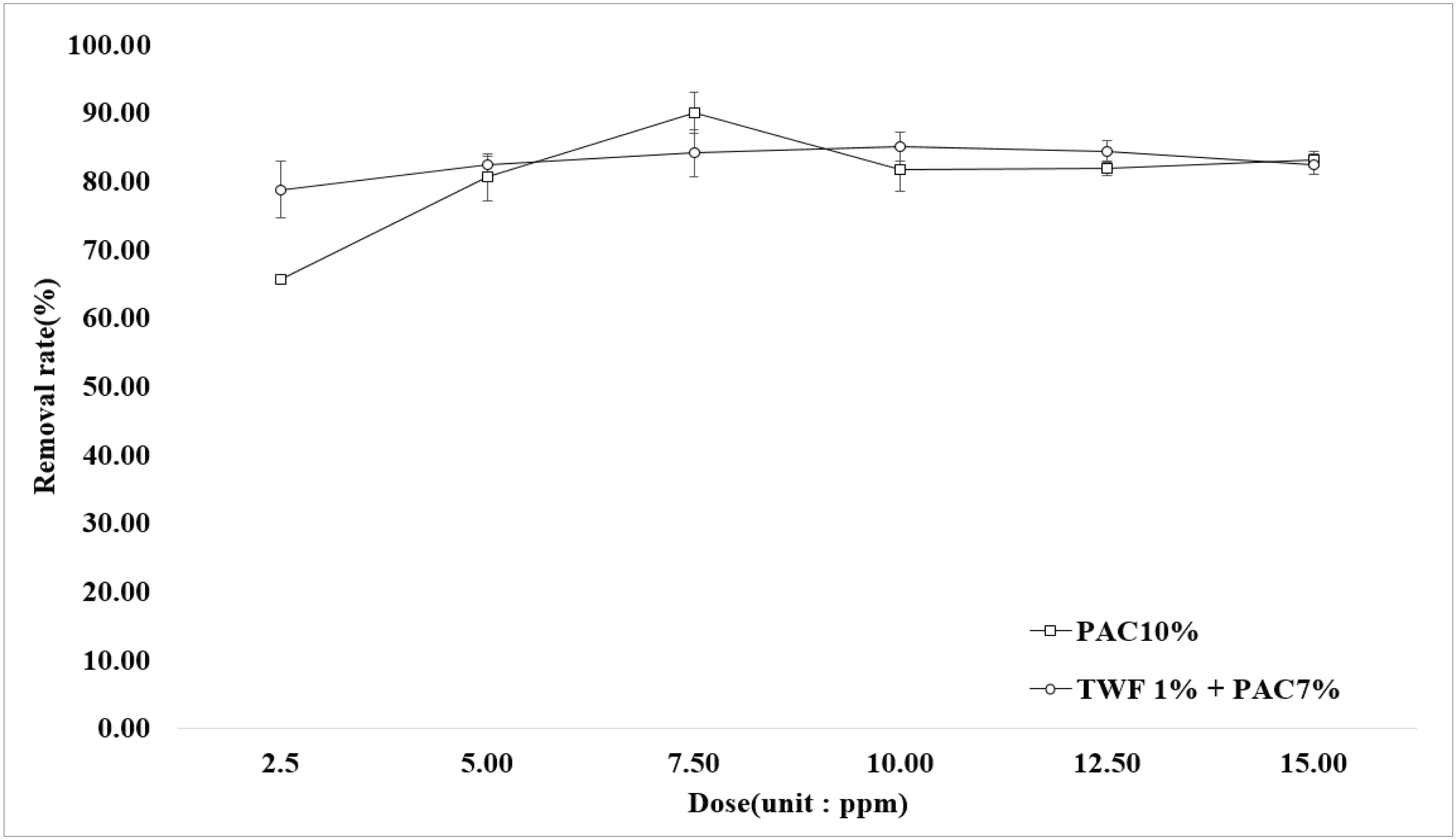
As shown in the following Fig. 3, it can be seen that Torrefied Wood Flour contains 1% and in the case of mixed coagulant which has PAC concentration of 7% shows T-P removal efficiency similar to PAC (10%). As a result of the previous experiment, the case of T-P showed a high removal efficiency of up to 91% when an injected concentration of coagulant was 10 ppm, and the case of PAC (10%) showed a removal efficiency similar to mixed coagulant with an efficiency of approximately 91% with the same coagulant injection.
The result of T-N removal efficiency according to the samples and input conditions of mixed coagulant and PAC (10%) coagulant is shown in Fig. 4. In the case of mixed coagulant, the removal efficiency was low as approximately 32% when the injection concentration was 10 ml and in the case of PAC (10%), the removal efficiency was approximately 35% when the injection concentration was 12.5 ml. This is determined to be occurred by a similar cause as the result of the previous experiment. It was judged that the coagulation effect appears to be low due to the low reactivity of the positively charged aluminum ion which is contained in the coagulation, and of the positively charged nitrogen compounds that make up total nitrogen.
The result of turbidity removal efficiency according to the samples and input conditions of mixed coagulant and PAC (10%) coagulant. In the case of turbidity, the removal efficiency by injection amount was shown to be similar to that of mixed coagulant and PAC (10%), and approximately 90% removal efficiency was shown when mixed coagulant was 10 ml, and approximately 92% removal efficiency when PAC (10%) was 12.5 ml.
The change in the concentration of aluminum in water according to the treatment conditions of the existing water treatment matter PAC, Torrefied Wood Flour mixed coagulant is shown in Fig. 6. Here, Control means the aluminum concentration of the primary settling pond’s outflowing water, and the concentration of aluminum remaining in the water when injecting and disposing of coagulants of TWF 1%+PACT 5%, TWF 1%+PAC 7%, and PAC 10%, respectively. The concentration of aluminum in the water of PAC 10% was approximately 3200 mg/L. It shows that under the condition of TWF 1%+5% PAC, the result was 930 mg/L, and 597 mg/L under the condition of 1% TWF+7% TWF+5% PAC. It shows that compared to PAC 10%, TWF 1%+PAC 7% were reduced by 3 times, and TWF 1%+PAC 5% were reduced by 5 times. In addition, according to concentration dilution, 2,240 mg/L and 1,600 mg/L underwater aluminum concentration shall be indicated. However, the difference from the dilution concentration is determined to be due to the Torrefied Wood Flour micropore which was activated by the carbonation process and the potential by absorption performance expressed.
The results of this study showed that the coagulation process was carried out using the mixed coagulant manufactured according to the optimal Torrefied Wood Flour content derived from the experiment and the appropriate concentration of PAC, resulting in removal efficiency similar to the injection amount of PAC (10%). The use of PACs for the management of total phosphorus is increasing, and according to 2017 sewage statistics, the domestic sewage treatment plants’ sewage system supply rate is 94%, which means the number of domestic sewage treatment plants is currently 660. Considering that the annual capacity of the domestic sewage treatment plant is 2,304,381 meters, the cost of injecting coagulant into the domestic sewage treatment plant is approximately 56,270,000,000 KRW per year. If the existing PAC is replaced by TWF 1%+PAC 7% which was developed through this study, it is determined that the existing coagulant injection will be reduced by 30%, which means 16.8 billion won can be secured as benefits of 30%, thereby securing the economic efficiency. Furthermore, the injection of PAC mixed with Torrefied Wood Flour in the primary settling pond can increase the size of floc by the coagulation with the underwater contaminants by Torrefied Wood Flour. Thus, the sedimentation velocity of underwater suspended solids can be increased. It is judged that due to the reduction of sedimentation time, the time to stay in the primary settling pond in the sewage treatment process could be reduced. As a result, it is concluded that environmental stability can be secured by reducing the concentration of aluminum in the water as the coagulant injection amount increases.
4. CONCLUSION
This study derived the optimal mixing ratio of mixed coagulant manufactured by combining PAC which is a coagulant in market with Torrefied Wood Flour that was overheat steam treated. In order to review the applicability of the mixed coagulant as a water treatment material, in-water organic compounds of T-P, T-N, and turbidity removal efficiency was analyzed when using the mixed coagulant. The followings results were drawn:
The optimal condition is the 1% addition rate of Torrefied Wood Flour in the market coagulant PAC (10%), and the analysis result of the removal efficiency of organic compound showed that when injecting 10 ml, T-P was up to 92%, T-N was approximately 22%, and turbidity was up to 91%. It was thus confirmed that the mixed coagulant developed in this study was applicable to the treatment of in-water organic compounds in the process of coagulation and blending.
According to the analysis of removal efficiency of organic compounds based on PAC concentration of 1%, which is the optimal amount of Torrefied Wood Flour, the removal efficiency of T-P 91%, T-N 32%, and the turbidity up to 90% were shown when 10 ml of 7% PAC concentration was injected.
PAC (10%) and the coagulation performance comparison experiment allowed the PAC concentration to be reduced by 30% to 50% when the coagulation process was carried out using a mixed coagulant based on 1% of Torrefied Wood Flour manufactured in this study. It has been confirmed that if used as a water treatment material using a mixed coagulant, the removal efficiency can be secured similar to that of the market coagulant PAC (10%).
Therefore, it can be determined that water treatment process by mixing and coagulation using Torrefied Wood Flour mixed coagulant developed in this study will secure economic and environmental effects, as well as removal efficiency similar to the existing coagulant PAC (10%). Although the removal efficiency has been verified, further studies need to be conducted on the size of floc and the principle of the substance removal according to the addition of Torrefied Wood Flour.

